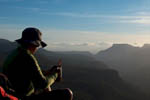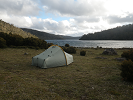Suggestion on a great orienteering compass?
Forum rules
TIP: The online Bushwalk Inventory System can help bushwalkers with a variety of bushwalk planning tasks, including: Manage which items they take bushwalking so that they do not forget anything they might need, plan meals for their walks, and automatically compile food/fuel shopping lists (lists of consumables) required to make and cook the meals for each walk. It is particularly useful for planning for groups who share food or other items, but is also useful for individual walkers.
TIP: The online Bushwalk Inventory System can help bushwalkers with a variety of bushwalk planning tasks, including: Manage which items they take bushwalking so that they do not forget anything they might need, plan meals for their walks, and automatically compile food/fuel shopping lists (lists of consumables) required to make and cook the meals for each walk. It is particularly useful for planning for groups who share food or other items, but is also useful for individual walkers.
15 posts
• Page 1 of 1
Suggestion on a great orienteering compass?
I plan to do some bush walking and would like to have a tough reliable waterproof compass that I can use as a backup to the iPhone. Any recommendations on one?
- L2obin
- Nothofagus gunnii

- Posts: 14
- Joined: Thu 18 Oct, 2012 12:08 am
- Region: New South Wales
Re: Suggestion on a great orienteering compass?
Usually, the better device would be the one relied upon first and the back up device would be the less accurate option. In other words, I'm saying I wouldn't be relying on using a smart phone. I'd only pull that out after my compass died and I was desperate for some kind of estimation.
In answer to your question. I reckon most compasses available from most shops would suffice. I am uncertain though about purchasing them online from overseas though as I believe the needle is designed to balance based upon specific regions of the globe. I am not sure how many different regions there are and the advertising material rarely states this.
Could some one elborate on this? I've never needed to travel over seas with a compass.
In answer to your question. I reckon most compasses available from most shops would suffice. I am uncertain though about purchasing them online from overseas though as I believe the needle is designed to balance based upon specific regions of the globe. I am not sure how many different regions there are and the advertising material rarely states this.
Could some one elborate on this? I've never needed to travel over seas with a compass.
- Gusto
- Athrotaxis cupressoides

- Posts: 375
- Joined: Wed 21 Sep, 2011 10:35 pm
- Region: Victoria
- Gender: Male
Re: Suggestion on a great orienteering compass?
Yep compasses are built for different magnetic regions, for example Silva use three zones, magnetic north (MN), magnetic equatorial (ME) and magnetic south (MS) they will have either MN, ME or MS in small letters on the bottom of the base plate (see reference here on the NZ Silva distributors website http://www.ampro.co.nz/products/silva/silva.htm near the bottom of the page). The needle that points north on magnetic north compass used here in the southern hemisphere will be tipped down and drag around on the base of the capsule.
I have the Silva Ranger, it has 1:25,000 scale on one side and 1:50,000 scale on the other plus mm ruler on front, I would never walk without a map and compass - don't have to worry about flat batteries... As far as waterproofing goes any sealed capsule type compass isn't going to be damaged by getting wet.
I have the Silva Ranger, it has 1:25,000 scale on one side and 1:50,000 scale on the other plus mm ruler on front, I would never walk without a map and compass - don't have to worry about flat batteries... As far as waterproofing goes any sealed capsule type compass isn't going to be damaged by getting wet.
-

beachcruiser - Athrotaxis cupressoides

- Posts: 114
- Joined: Thu 02 Feb, 2012 12:45 pm
- Location: Illawarra, NSW
- Region: New South Wales
- Gender: Female
Re: Suggestion on a great orienteering compass?
See this topic for extensive discussion and useful links regarding the issue of using different compasses for different magnetic regions of the earth.
- Son of a Beach
- Lagarostrobos franklinii

- Posts: 6930
- Joined: Thu 01 Mar, 2007 7:55 am
- ASSOCIATED ORGANISATIONS: Bit Map (NIXANZ)
- Region: Tasmania
- Gender: Male
Re: Suggestion on a great orienteering compass?
The best base plate compass out there is the Suunto M-3G Global needle compass. Works in northern or southern hemi, clinometer, adjustable magnetic variation.
-

edwinsoh - Nothofagus gunnii

- Posts: 15
- Joined: Wed 17 Aug, 2011 4:40 pm
- Region: Other Country
- Gender: Male
Re: Suggestion on a great orienteering compass?
+1 for the Suunto M-3G. For navigation purposes I'd rather have 2 of these than 1 magnetic compass and a mobile phone. As it has a global needle just shop wherever it is cheapest. If you don't want to go for the the M-3G I'd recommend something with at least an adjustable magnetic variation so you can avoid having to do the calculations at a time when you're stressed in some way and accuracy is critical.
- McWade
- Atherosperma moschatum

- Posts: 76
- Joined: Fri 24 Aug, 2012 6:36 pm
- Region: Western Australia
- Gender: Male
Re: Suggestion on a great orienteering compass?
The Suunto sounds good! Is there any advantage to getting the MC-2 G? Supposedly they are the same compass but the MC-2 G has the mirror sight. Does this mean one can get a much more accurate bearing of an object.. somewhat like a lensatic compass?
- L2obin
- Nothofagus gunnii

- Posts: 14
- Joined: Thu 18 Oct, 2012 12:08 am
- Region: New South Wales
Re: Suggestion on a great orienteering compass?
The mirrored compasses will give a more accurate bearing but in many situations that increase in accuracy carries no real benefit. A mirrored compass does provide a mirror for emergency signalling, putting in you contact lenses or checking out other parts of ones anatomy for damage, repair etc.
"Perfection is attained not when there is nothing more to add, but when there is nothing more to remove".
-

Mark F - Lagarostrobos franklinii

- Posts: 2301
- Joined: Mon 19 Sep, 2011 8:14 pm
- Region: Australian Capital Territory
- Gender: Male
Re: Suggestion on a great orienteering compass?
Any suggestions on where is the best place to pick one up? Shipping from US seems prohibitive =(
- L2obin
- Nothofagus gunnii

- Posts: 14
- Joined: Thu 18 Oct, 2012 12:08 am
- Region: New South Wales
Re: Suggestion on a great orienteering compass?
L2obin wrote:Any suggestions on where is the best place to pick one up? Shipping from US seems prohibitive =(
http://www.ebay.com.au/itm/Suunto-M3-Gl ... 108wt_1186
-

Strider - Lagarostrobos franklinii

- Posts: 5875
- Joined: Mon 07 Nov, 2011 6:55 pm
- Location: Point Cook
- Region: Victoria
- Gender: Male
Re: Suggestion on a great orienteering compass?
Strider wrote:L2obin wrote:Any suggestions on where is the best place to pick one up? Shipping from US seems prohibitive =(
http://www.ebay.com.au/itm/Suunto-M3-Gl ... 108wt_1186
Do note the scales on the item before purchase. The Suunto M3G has inch or cm scales. For Australian and UK maps get those with 1:25K, 1:20K, etc.
-

edwinsoh - Nothofagus gunnii

- Posts: 15
- Joined: Wed 17 Aug, 2011 4:40 pm
- Region: Other Country
- Gender: Male
Re: Suggestion on a great orienteering compass?
Also, I find it handy to choose a model with Declination Adjustment. This way, you set the compass for the area you are in, and you can work with true bearings.
Michael
-

photohiker - Lagarostrobos franklinii

- Posts: 3097
- Joined: Sun 17 May, 2009 12:31 pm
- Location: Adelaide, dreaming up where to go next.
Re: Suggestion on a great orienteering compass?
Just saying, the 'Marine Compass' app for Android is absolutely spot on to a compass when the phone is on and operational.
If only all the people who helped us get to where we are, were here to save us from where we are.
Me
Me
-

Taz73 - Nothofagus gunnii

- Posts: 32
- Joined: Wed 13 Jun, 2012 10:05 pm
- Region: Tasmania
Re: Suggestion on a great orienteering compass?
L2obin, unless you are planning to use the compass for walking overseas, you don’t really need a globally-balanced compass, (such as the Suunto M2 or M3 Global, or the Silva/Brunton equivalents - I have a Brunton-made Silva Voyager 8010 global compass with Brunton’s signature yellow base plate, which I quite like). An entry-level base plate compass from Silva or Suunto or Brunton will be fine, (and a lot cheaper too), especially if you are just starting out using a compass when walking.
I have acquired a lot of compasses over the years, (and my oldest is an elderly handed-down air dampened Silva base plate, which still works admirably and is still accurate), but my go-to compass is a 20 years old Silva Expedition 54; it’s a combined sighting and base plate compass with sighting accuracy of 0.5º, but it sells in Australia for around the $200+ mark, so it's a bit of an overkill for a ‘first’ compass. The Silva Expedition series compasses have 1:25,000 and 1:50,000 Romer scales, (which the Suunto’s don’t seem to have - I only have one Suunto, an old GPS Global Plotter and it has no Romer scales, and the M2 and M3’s certainly don’t have them either). The Silva Expedition 54 uses Silva’s larger Type 4 base plate. I use my 54 regularly, as I mostly do off-track walking and often solo. I also carry a Garmin GPS, but I usually only turn it on at night, to check up on my navigation (and not always, when it is very obvious where I am). Mostly, it’s just a map and compass. No batteries needed.
I would be looking at a simpler less expensive 'localised' southern hemisphere compass first up. There are lots of options and they are decidedly cheaper. And, at the end of the day, they work just the same. You could have a look at a Suunto A-30 or a Silva Ranger, neither of which have Romer scales on their base plates, or the Silva Expedition, which does, as it has the same base plate as its more expensive sibling, the Silva Expedition 54.
For me the singular drawback with the global compasses from both Suunto and Silva, aside from their higher cost, is that they don't have Romer scales marked into their base plates. As we walk with maps overlaid with UTM, no Romer scales mean always fiddling around when measuring onto the map. The in-built Romer scales on a good locally-weighted base plate compass such as the Silva Expedition make that task so much easier, not to mention more precise. (My Silva Voyager 8010, which I use when walking in Asia, has no Romer scales, which is one reason why I like it slightly less than my Silva Expedition 54.)
I value Romer scales on a base plate more than I do a separate declination adjustment, (one can always do the calculation or swivel the compass bezel accordingly), or a marked clinometer scale, for that matter. Having said that the Silva Expedition has Romer scales and declination adjustment and a clinometer scale marked.
Just saying. I have no commercial connection to Silva, or Suunto, or Brunton; I am just a humble compass user with a lot of compasses.
rucksack
I have acquired a lot of compasses over the years, (and my oldest is an elderly handed-down air dampened Silva base plate, which still works admirably and is still accurate), but my go-to compass is a 20 years old Silva Expedition 54; it’s a combined sighting and base plate compass with sighting accuracy of 0.5º, but it sells in Australia for around the $200+ mark, so it's a bit of an overkill for a ‘first’ compass. The Silva Expedition series compasses have 1:25,000 and 1:50,000 Romer scales, (which the Suunto’s don’t seem to have - I only have one Suunto, an old GPS Global Plotter and it has no Romer scales, and the M2 and M3’s certainly don’t have them either). The Silva Expedition 54 uses Silva’s larger Type 4 base plate. I use my 54 regularly, as I mostly do off-track walking and often solo. I also carry a Garmin GPS, but I usually only turn it on at night, to check up on my navigation (and not always, when it is very obvious where I am). Mostly, it’s just a map and compass. No batteries needed.
I would be looking at a simpler less expensive 'localised' southern hemisphere compass first up. There are lots of options and they are decidedly cheaper. And, at the end of the day, they work just the same. You could have a look at a Suunto A-30 or a Silva Ranger, neither of which have Romer scales on their base plates, or the Silva Expedition, which does, as it has the same base plate as its more expensive sibling, the Silva Expedition 54.
For me the singular drawback with the global compasses from both Suunto and Silva, aside from their higher cost, is that they don't have Romer scales marked into their base plates. As we walk with maps overlaid with UTM, no Romer scales mean always fiddling around when measuring onto the map. The in-built Romer scales on a good locally-weighted base plate compass such as the Silva Expedition make that task so much easier, not to mention more precise. (My Silva Voyager 8010, which I use when walking in Asia, has no Romer scales, which is one reason why I like it slightly less than my Silva Expedition 54.)
I value Romer scales on a base plate more than I do a separate declination adjustment, (one can always do the calculation or swivel the compass bezel accordingly), or a marked clinometer scale, for that matter. Having said that the Silva Expedition has Romer scales and declination adjustment and a clinometer scale marked.
Just saying. I have no commercial connection to Silva, or Suunto, or Brunton; I am just a humble compass user with a lot of compasses.
rucksack
-

rucksack - Athrotaxis cupressoides

- Posts: 277
- Joined: Tue 25 Dec, 2007 9:16 pm
- Location: Cygnet
- Region: Tasmania
- Gender: Male
Re: Suggestion on a great orienteering compass?
post script
I was just looking at the Suunto website and remembered that they have a wholly owned Swiss subsidiary, which makes compasses under the Recta brand. These are actually made in Finland at Suunto Oy, but they are quite distinct models to the Suunto offerings. One Recta compass that might be worth a look is the Recta DT 420. It is available in Australia in two versions: a Southern Hemisphere (SH) version, the DT 420 and a Global version, the DT 420G, with the later being a good deal more expensive than the former. Aside from the globally balanced needle in the 420G, the two compasses are otherwise identical. Both have Romer scales, adjustable declination correction, a built in clinometer, a magnifier, and a decent baseplate, so they tick all the boxes.
rucksack
I was just looking at the Suunto website and remembered that they have a wholly owned Swiss subsidiary, which makes compasses under the Recta brand. These are actually made in Finland at Suunto Oy, but they are quite distinct models to the Suunto offerings. One Recta compass that might be worth a look is the Recta DT 420. It is available in Australia in two versions: a Southern Hemisphere (SH) version, the DT 420 and a Global version, the DT 420G, with the later being a good deal more expensive than the former. Aside from the globally balanced needle in the 420G, the two compasses are otherwise identical. Both have Romer scales, adjustable declination correction, a built in clinometer, a magnifier, and a decent baseplate, so they tick all the boxes.
rucksack
-

rucksack - Athrotaxis cupressoides

- Posts: 277
- Joined: Tue 25 Dec, 2007 9:16 pm
- Location: Cygnet
- Region: Tasmania
- Gender: Male
15 posts
• Page 1 of 1
Who is online
Users browsing this forum: Google [Bot], Google Adsense [Bot] and 70 guests
